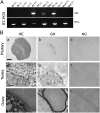Gonads directly regulate growth in teleosts
- PMID: 22733736
- PMCID: PMC3396507
- DOI: 10.1073/pnas.1118704109
Gonads directly regulate growth in teleosts
Abstract
In general, there is a relationship between growth and reproduction, and gonads are known to be important organs for growth, but direct evidence for their role is lacking. Here, using a fish model, we report direct evidence that gonads are endocrine organs equal to the pituitary in controlling body growth. Gonadal loss of function, gain of function, and rescue of growth were investigated in tilapia. Gonadectomy experiments were carried out in juvenile males and females. Gonadectomy significantly retarded growth compared with controls; however, this retardation was rescued by the implantation of extirpated gonads. Because gonads express growth hormone, it is possible that gonads control body growth through the secretion of growth hormone and/or other endocrine factors. We propose that gonads are integral players in the dynamic regulation of growth in teleosts.
Conflict of interest statement
The authors declare no conflict of interest.
Figures






Similar articles
-
Insulin-like growth factors and fish reproduction.Biol Reprod. 2010 Apr;82(4):656-61. doi: 10.1095/biolreprod.109.080093. Epub 2009 Oct 28. Biol Reprod. 2010. PMID: 19864315 Review.
-
Hypothalamic- and pituitary-derived growth and reproductive hormones and the control of energy balance in fish.Gen Comp Endocrinol. 2020 Feb 1;287:113322. doi: 10.1016/j.ygcen.2019.113322. Epub 2019 Nov 15. Gen Comp Endocrinol. 2020. PMID: 31738909 Review.
-
Control of leptin by metabolic state and its regulatory interactions with pituitary growth hormone and hepatic growth hormone receptors and insulin like growth factors in the tilapia (Oreochromis mossambicus).Gen Comp Endocrinol. 2017 Jan 1;240:227-237. doi: 10.1016/j.ygcen.2016.07.017. Epub 2016 Jul 19. Gen Comp Endocrinol. 2017. PMID: 27449341 Free PMC article.
-
Endocrine regulation of gonadotropin and growth hormone gene transcription in fish.Comp Biochem Physiol C Pharmacol Toxicol Endocrinol. 1998 Jun;119(3):325-38. doi: 10.1016/s0742-8413(98)00021-8. Comp Biochem Physiol C Pharmacol Toxicol Endocrinol. 1998. PMID: 9827005 Review.
-
Molecular characterization of the gonadal kisspeptin system: Cloning, tissue distribution, gene expression analysis and localization in sablefish (Anoplopoma fimbria).Gen Comp Endocrinol. 2016 Jan 1;225:212-223. doi: 10.1016/j.ygcen.2015.07.015. Epub 2015 Sep 16. Gen Comp Endocrinol. 2016. PMID: 26386183
Cited by
-
High-Density Linkage Map and QTLs for Growth in Snapper (Chrysophrys auratus).G3 (Bethesda). 2019 Apr 9;9(4):1027-1035. doi: 10.1534/g3.118.200905. G3 (Bethesda). 2019. PMID: 30804023 Free PMC article.
-
Sex steroid production associated with puberty is absent in germ cell-free salmon.Sci Rep. 2017 Oct 3;7(1):12584. doi: 10.1038/s41598-017-12936-w. Sci Rep. 2017. PMID: 28974703 Free PMC article.
-
Identification and Characterization of a Non-muscular Myostatin in the Nile Tilapia.Front Endocrinol (Lausanne). 2020 Feb 28;11:94. doi: 10.3389/fendo.2020.00094. eCollection 2020. Front Endocrinol (Lausanne). 2020. PMID: 32180761 Free PMC article.
-
Deciphering Direct and Indirect Effects of Neurokinin B and GnRH in the Brain-Pituitary Axis of Tilapia.Front Endocrinol (Lausanne). 2019 Jul 12;10:469. doi: 10.3389/fendo.2019.00469. eCollection 2019. Front Endocrinol (Lausanne). 2019. PMID: 31354632 Free PMC article.
-
Plasticity in medaka gonadotropes via cell proliferation and phenotypic conversion.J Endocrinol. 2020 Apr;245(1):21-37. doi: 10.1530/JOE-19-0405. J Endocrinol. 2020. PMID: 31977313 Free PMC article.
References
-
- Fairbair D-J. Allometry for sexual size dimorphism: Pattern and process in the coevolution of body size in males and females. Annu Rev Ecol Syst. 1997;28:659–687.
-
- Norman J-R. A Systematic Monograph of the Flatfishes (Heterosomata), 1: Psettodidae, Bothidae, Pleuronectidae. London: British Museum; 1934.
-
- Kobelkowsky A. Sexual dimorphism of the flounder Bothus robinsi (Pisces: Bothidae) J Morphol. 2004;260:165–171. - PubMed
-
- Lowe-McConnel R-H. Ecological Studies in Tropical Fish Communities. Cambridge, UK: Cambridge Univ Press; 1987.
-
- Zakes Z, Demska-Zakes K. Effect of diets on growth and reproductive development of juvenile pikeperch, Stizostedion lucioperca (L.), reared under intensive culture conditions. Aquacult Res. 1996;27:841–845.
Publication types
MeSH terms
Substances
LinkOut - more resources
Full Text Sources

